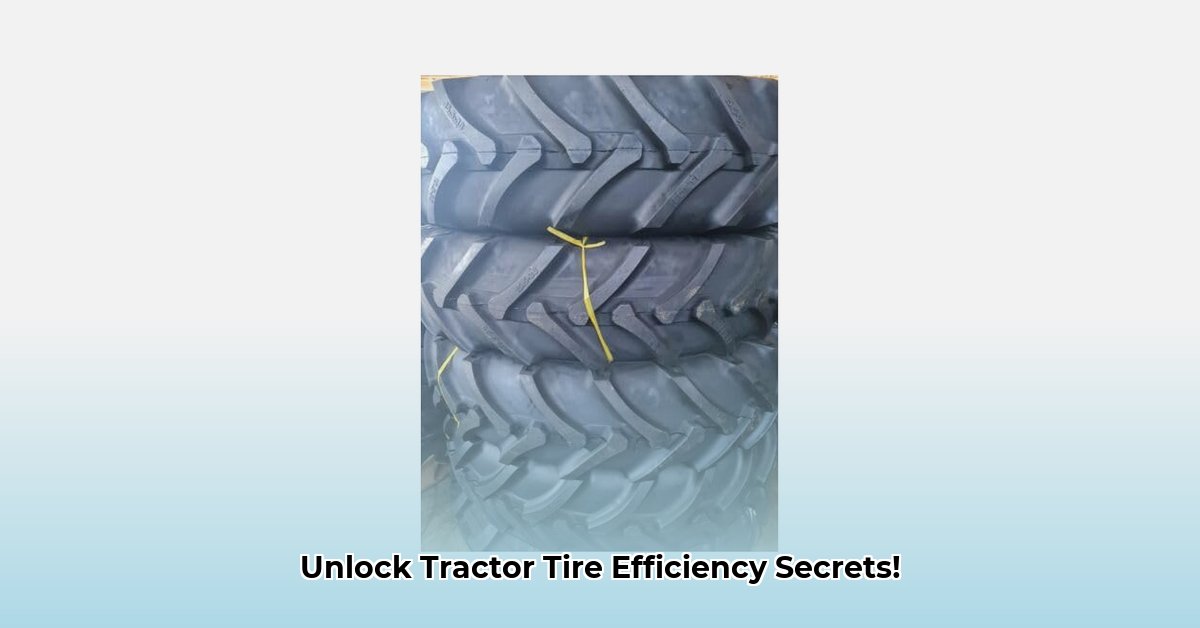
15.5-38 Tractor Tires: A Review Focused on Sustainable Agriculture
Choosing the right tractor tires is paramount for efficient and sustainable farming. This article examines the impact of 15.5-38 tractor tires, using the BKT TR135 as a case study, on fuel efficiency, soil compaction, and overall environmental sustainability. While detailed data on the BKT TR135's specific lifecycle and material composition is limited, we can still analyze its potential contribution to sustainable agriculture. For comparison, see data on other tire sizes like 7.50-16 tractor tires.
BKT TR135: A Preliminary Assessment
The BKT TR135, a 15.5-38 tire, offers a 3900-pound load capacity. This potentially translates to fewer passes across the field, directly reducing fuel consumption and minimizing soil compaction. However, crucial information regarding the tire's lifespan, material composition (including recycled content), and end-of-life recyclability is currently unavailable. This lack of data hinders a comprehensive assessment of its environmental impact. This underscores a broader need for greater transparency from tire manufacturers regarding sustainability metrics.
Potential Advantages:
- High Load Capacity: The potential for fewer field passes due to higher load capacity directly translates to fuel savings and reduced soil compaction. Doesn't this sound promising for a sustainable future?
- Reduced Fuel Consumption (Potential): Fewer passes mean less fuel usage, resulting in lower operational costs and a smaller carbon footprint. How significant are these savings likely to be?
- Improved Soil Health (Potential): Minimized compaction improves soil structure, water retention, and overall crop health. What are the long term consequences of poor soil health?
Potential Disadvantages:
- Data Scarcity: The lack of comprehensive data on the tire's lifecycle and materials used restricts a full evaluation of its environmental impact. How can we effectively assess sustainability without complete information?
- Uncertain Environmental Footprint: Without detailed material sourcing and end-of-life data, we can't accurately gauge the tire's overall environmental effect. What are the hidden costs of unsustainable tire production?
- Cost-Effectiveness Uncertainty: While potential fuel savings exist, a complete cost-benefit analysis requires data on lifespan and replacement costs. How do we account for the full cost of ownership?
Sustainable Farming Practices and Tractor Tire Selection
Sustainable agriculture necessitates minimizing environmental impact while maximizing efficiency. Tractor tire selection plays a crucial role in achieving this balance. Improper tire selection leads to increased fuel consumption, soil compaction, and an enlarged carbon footprint. Conversely, responsible choices contribute to soil health, reduced greenhouse gas emissions, and improved farm profitability.
The Tire Lifecycle and Environmental Responsibility
The environmental impact of tires extends beyond their operational use. Manufacturing, transportation, and ultimate disposal all contribute to the overall carbon footprint. Ideally, agricultural tires should be manufactured using recycled materials, designed for extended lifespan, and easily recyclable at the end of their functional life. A move towards closed-loop tire systems is crucial for minimizing waste and reducing reliance on virgin materials. How can we collectively support more sustainable tire manufacturing?
Practical Tips for Sustainable Tire Management
Maintain Proper Inflation: Always maintain the manufacturer's recommended tire pressure. Under-inflation increases rolling resistance and fuel consumption, whereas over-inflation reduces traction and can damage the tire. How much fuel can be saved by maintaining optimal tire pressure?
Implement Controlled Traffic Farming: Plan your field routes to minimize passes across the same areas, thus reducing compaction. This practice can improve overall soil health and minimize environmental impact. What are the long-term benefits of controlled traffic systems?
Regular Tire Inspections: Conduct frequent visual inspections to detect cuts, wear, or damage early on. Prompt attention to such issues helps extend tire lifespan and avoid costly repairs. How can this simple practice lead to cost savings over tire life?
Choose Appropriate Tire Types: Select tires suited to specific tasks and soil conditions. The use of flotation tires, for example, reduces compaction while maintaining sufficient traction on lighter soils. What are the benefits of this tailored approach?
The Path Forward: Collaboration for Sustainable Agriculture
Moving towards a truly sustainable future in agriculture requires collaboration among farmers, tire manufacturers, researchers, and policymakers.
- Comprehensive Life Cycle Assessments (LCAs): LCAs for various 15.5-38 tires are needed to compare their total environmental impact across their entire lifecycle.
- Rigorous Field Testing: Real-world testing under various soil conditions is crucial for validating manufacturers’ claims regarding fuel efficiency and soil compaction.
- Transparent Material Disclosure: Manufacturers should provide complete information about tire composition, including the percentage of recycled and sustainable materials employed.
- Development of Effective Recycling Solutions: Innovative, environmentally-friendly solutions for end-of-life agricultural tire disposal are urgently required.
By working collaboratively, we can gather robust data, drive innovation in agricultural tire technology, and create more sustainable farming practices. What steps can we take today to improve sustainable agricultural tire use?